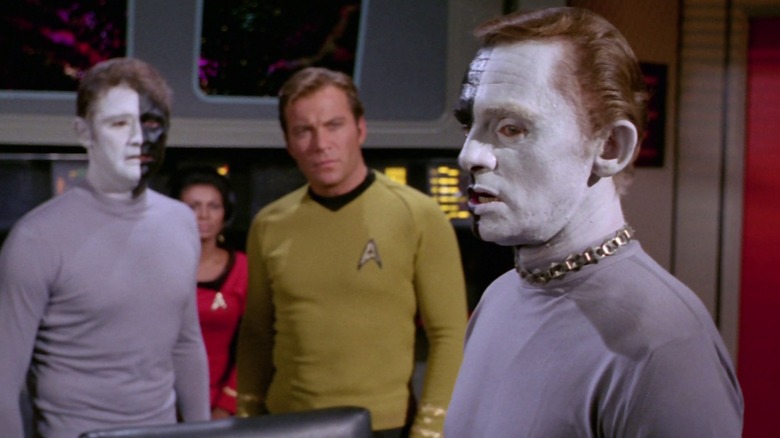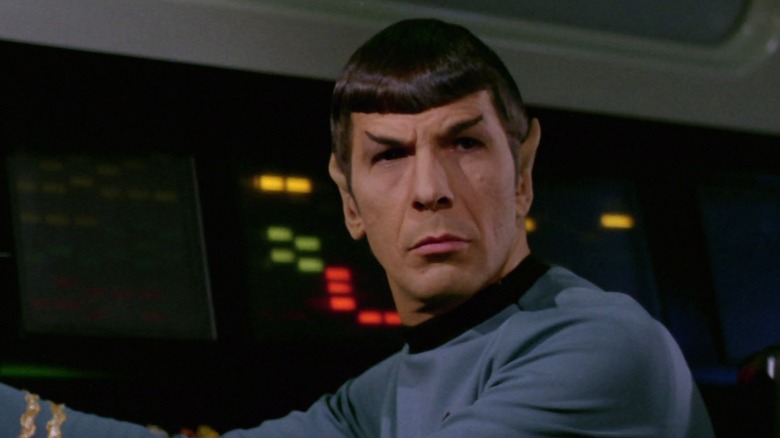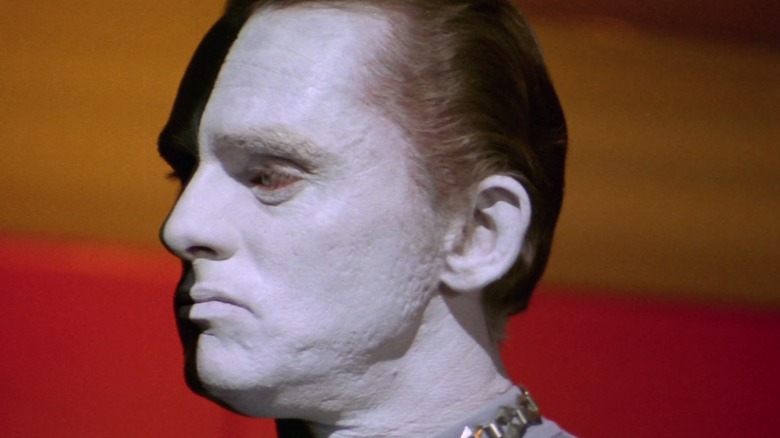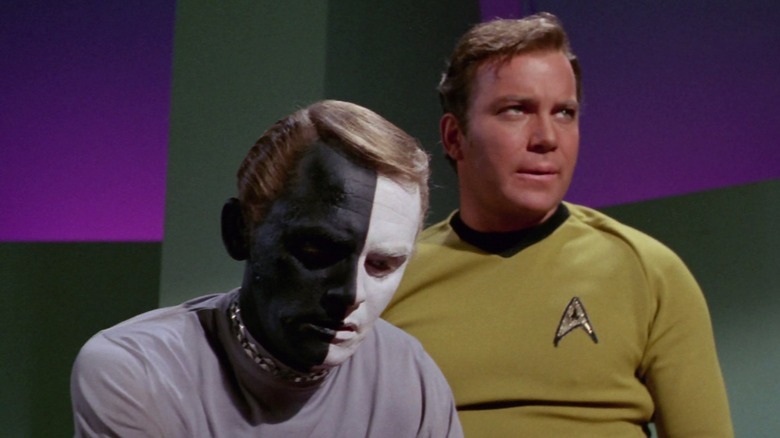Star Trek: Section 31 Subtly Redeems A Polarizing Original Series Species
We may receive a commission on purchases made from links.
This post contains spoilers for "Star Trek: Section 31."
There's a tendency among TV and film fans — or consumers of any type of pop culture, really — to let past portrayals off the hook by defining them as "of their time" or as something that "couldn't be made today." It's one of the most insidious habits we have as viewers, and it's usually flat-out wrong. Marginalized people have been fighting to be represented accurately on screen for as long as visual media has existed. Bigot-led '70s sitcom "All in the Family" was considered network poison before it became a hit, lesbian readers were already sick of sad gay love stories by the '50s, and Disney's famously racist film "Song of the South" was controversial even before its 1946 release.
It's easy to fall into the trap of assuming that history was somehow more one-dimensional, hateful, or backwards by default than it is today, and that trap can lead us to give credit where it isn't exactly due. Case in point: when I was a young teen, I thought the season 3 "Star Trek: The Original Series" episode "Let That Be Your Last Battlefield," which ties into the new "Star Trek" film "Section 31" in an unexpected way (more on that later), was a really good metaphor for racism. Sure, its visual representation of the social constructs of race — people with half-white, half-black faces battling against people with nearly indistinguishable half-black, half-white faces — was a bit heavy-handed, but I found Gene Roddenberry's central message, about the power of bigotry to destroy society, important. It surely was when it first came out, right?
Let That Be Your Last Battlefield is a frustrating racial allegory
Not entirely. The original "Star Trek" series was endlessly groundbreaking in nearly every way, including in its portrayals of racial diversity. It was Dr. Martin Luther King, Jr. who convinced Nichelle Nichols not to quit the show between seasons, after all. But despite my misguided eighth-grade epiphany that this extra-blatant episode could change hearts and minds, "Let That Be Your Last Battlefield" has always been considered obvious and oversimplified — if not outright offensive — by some. It came out in 1969, after all, when Black Americans had already been leading the civil rights movement for years. By that point, America didn't need checkered face paint to know what was wrong with it. The episode also hinges on several false equivalencies that serve to "both-sides" conversations around racism, with the holier-than-thou, apparently bigotry-free Enterprise crew considering slave liberator Lokai (Lou Antonio) a man of "extreme viewpoints" just like age-old oppressor Bele (Frank Gorshin).
The episode is, frankly, an ideological mess. Novelist J. Neil Schulman wrote in his book "Profile in Silver" that Harlan Ellison, who himself penned one of the best "Star Trek" episodes of all time, "hated that episode." In John Tullock and Henry Jenkins' 1995 book "Science Fiction Audiences," the authors list "Let That Be Your Last Battlefield" as one of a handful of TOS episodes that are "often regarded as among the worst moments of the series," representative of the "most generic elements" of the franchise and "displaying its ideology in its crudest form." The central characters' two-tone makeup has even been compared to Blackface. The racial allegory at the heart of the episode was so clumsy and imperfect that the episode's central species, the Cherons, was never seen on screen again after 1969.
Until now.
Star Trek: Section 31 features a Cheron supporting character
Let's get one thing straight right away here: the new movie "Star Trek: Section 31," the first "Star Trek" feature film of the Paramount+ era, neither "solves racism" nor attempts to. The splashy, silly, fast-paced caper pulls as much inspiration from Guy Ritchie movies, "Ocean's Eleven," and D.C. Comics as it does from Roddenberry's honor-driven, optimistic flagship series. There is no big metaphor here, nor any bigger picture. It does, however, include the first Cheron character fans have seen in over 50 years (with the exception of a blink-and-you'll-miss-it background gag in "Star Trek: Lower Decks"). Their name is Virgil, and they're clearly a scene-stealing diva.
Virgil appears right around the time that viewers will begin to realize that "Section 31" is way more camp than they expected, and that it possesses a sense of humor, flamboyance, and looseness that die-hard "Trek" fans will either love or (perhaps more likely) hate. The character pops up in a scene early in the film, when we see what the Mirror Universe version of "Star Trek: Discovery" villainess Philippa Georgiou has been up to in the years since the film's prologue showed her killing her family and maiming her true love. Actor Augusto Bitter, whose past credits include the film "White Muscle Daddy," the horror series "EZRA," and the short film "Chicho," plays Virgil.
We learn pretty much nothing about Virgil in this movie, yet they somehow still manage to make a strong impression. Their job title is never revealed, but it's clear they work as a sort of bar host-slash-right-hand-alien to Philippa, whose makeup and costuming in this scene reveal that we're now meant to see her as a stylish baddie, not a tyrannical ruler. We immediately code Virgil as a sort of oddball lackey — they laugh when relaying the news that a bride "molted just as things came to a climax" in the honeymoon suite — but also as a competent ally to Philippa with a flair for drama.
This species deserves to be freed from its messy metaphor
Virgil is decked out in glitter and jewels, but they're still clearly a Cheron, a fact that's never addressed — and perhaps not a big deal at this time, and in this area of the galaxy. It's a refreshing contrast to the original series episode, in which DeForest Kelley's Dr. McCoy declares the Cherons an inexplicable mutation, and quite tellingly says that if he had their biological capabilities, he'd be one of the most powerful specimens around. The implication there, of course, is that the Cherons can never reach their full potential the way a white, male human could because of their surface-level physical difference.
As relatively inconsequential as the character's presence is in the scheme of things, it's nice just to see the Cheron native in "Section 31" freed from the limitations of a rather binary and basic half-century-old metaphor. Instead, Virgil is given the gift of being just some person, living their best life in a seedy bar and appearing to have a great time doing so. The Paramount+ "Trek" era hasn't been perfect, but it's done a pretty great job rehabbing some of the species featured in earlier "Star Trek" shows who got the short end of the stick during their first contact missions. The Cherons were among the most shallowly considered; despite their poetically tragic "TOS" conclusion, viewers are told very little about them — outside of their hatred for those who don't match their appearance.
Now we know that the long-forgotten species is made up of more than the sum of their conflicts, and maybe that added layer offers a tiny bit of redemption for a wonky original series episode. After all, if they can be funky evil sidekicks with a warped sense of humor, the Cherons can be anything. Just, you know, not if they're all doomed to kill each other for the sake of a painfully tidy lesson about tolerance.
"Star Trek: Section 31" is now streaming on Paramount+.



